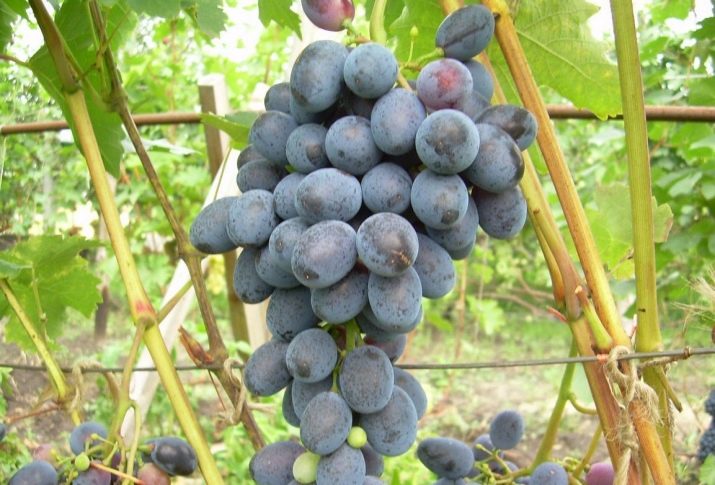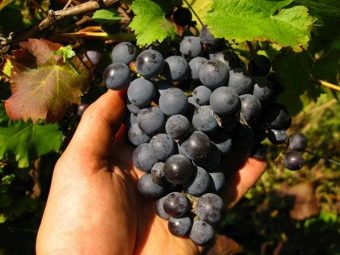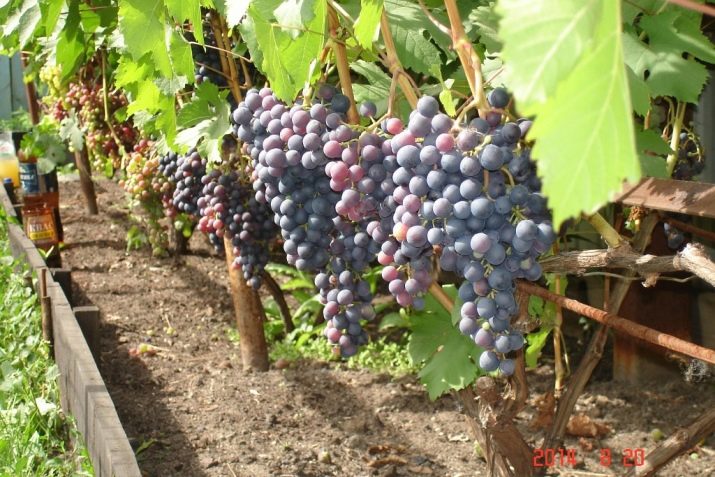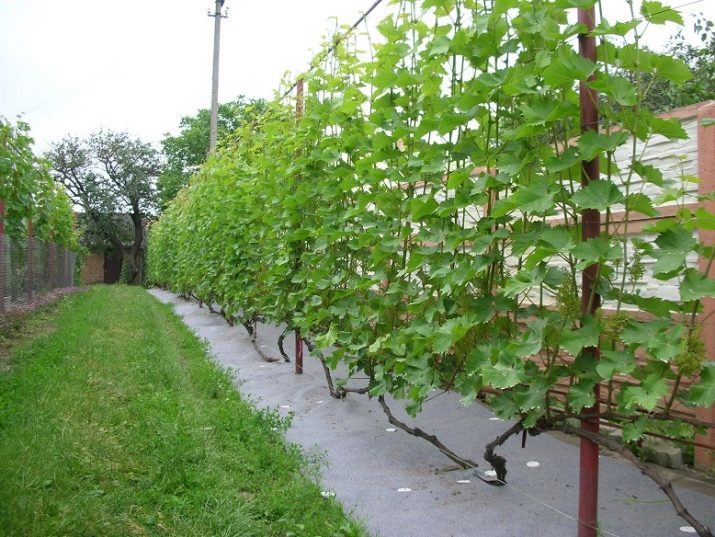What grapes of early grapes are the best?
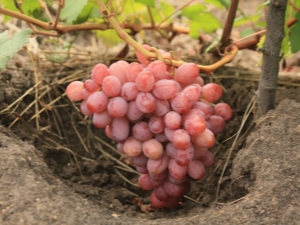
Tasty and healthy grapes since ancient times divorced by mankind. There are several hundred varieties of this product on our planet. There are table and raisin, as well as wine grape varieties. In addition, the grapes are well preserved for the winter, make compote from it. Due to the huge amount of minerals and organic substances, grapes are very useful for humans. In this article, we will analyze a variety of grape varieties and determine what their characteristics and differences.
Special features
For some reason, not every amateur goes to grow grapes on his own plot, so that at the same time he does not disappear in winter, does not rot in the summer season and brings a rich collection. It is necessary to start growing this culture responsibly and thoroughly.
First of all, it is necessary to choose the optimal grape variety that will grow well in each specific region. For example, the cultivation of a vineyard in central Russia brings excellent results, but only under the condition of planting cold-resistant species with early maturity. Among the newest varieties, one can find fairly good varieties that are resistant to fungal diseases, pests and extreme cold, with significant yields and the ability to keep up even in the cloudy summer period.
Early grape varieties differ from ordinary types in that they:
- more resistant to temperature changes;
- have good resistance to frost;
- tolerate heat and drought well;
- more resistant to disease;
- unpretentious care.
Early varieties of this plant need about four months to ripen sweet berries. At the same time, a bunch is formed and it has time to mature completely in such a short period. Early ripening grapes in August delight summer people with a tasty and abundant harvest.
Varieties
Good description and characteristics have ultra early varieties, such as Novocherkassk Red, Rubtsovoy, Pineapple, Raduzhny, Firstborn, TSHA, etc. Their planting is not very complicated.
The following varieties can also be distinguished among early-ripe species.
Grade "Russian"
It was bred from two varieties called Michurinets and Shasly Severnaya. This is a dessert table grape that has an early aging period. The variety is high-yielding, although the berries have small and compact clusters.
The Russian variety is ideal for the center of Russia, it bears fruits well in the Urals and in the cool climate of Siberia. Differs in unpretentious care, which includes autumn pruning and regular watering.
2-3 shoots are usually tied on the shoots, and one vine can produce up to 25 kg of crop.
Specifications:
- frost resistance to - 23 degrees;
- sugar content - up to 21%;
- acid indicators - up to 6-7 g / l;
- bunch weight - from 300 to 500 g
The variety has dark pink small berries, with a white waxy coating, slightly sourish in taste, but with a sweet caramel flavor.
According to reviews of amateur gardeners, the grapes of this variety are very unpretentious and tasty, have good keeping quality, which is important when storing the crop for a long period of time.
"Pink early"
Kishmishny seedless grape variety. Differs large clusters that have a little winged shape. The usual weight of one bunch is from 250 to 380 grams, but in a productive year it is possible to get a bunch weighing up to 500 g.
Characteristics of the variety:
- the color of the berries is white, with a gold barrel;
- the mass of one berry is about 1.3-1.4 g;
- dense juicy pulp;
- sweet taste;
- high level of sugar content (13-15%);
- low acidity, no more than 5-6 g / l.
Vine has a chic openwork crown, which can become a decoration of landscape design. Reviews of this variety are only positive. Summer residents consider it the best option for growing on their plots.
"Purple early"
It is a versatile variety, with enhanced resistance to various infections and low temperatures. Berries are medium in size, clusters weighing 80-150 g.
Characteristics of the variety:
- the color of the berries is purple;
- the mass of one berry is about 1.3-1.5 g;
- berry size 1.3-1.6 cm;
- clusters of conical shape;
- dense juicy pulp, taste of nutmeg;
- sweet taste;
- high level of sugar content (13-15%);
- low acidity, no more than 5-6 g / l.
The vegetation period until full maturity of the crop is 130 days. The food can be eaten in September. And for winemaking collection is carried out at the end of the month. This variety has a high yield.
The purple variety has a good resistance to infections, a bunch of leafworms and bacterial cancer.
The variety has an increased resistance to frost - up to -25 degrees.
Reviews of winegrowers only good, because the variety with an early term of ripening and simplicity in the care, such a large volume of harvest.
"Gourmet"
Excellent hybrid appearance with a nutmeg flavor. It has unpretentious care, so it is often grown in ordinary cottages and household plots.
Tall table grapes, different super-early maturation. Clusters look quite appetizing, and have great taste.
Specifications:
- the color of the berries is pink, closer to lilac;
- the mass of one berry is up to 10 g;
- dense, sweet and juicy pulp;
- seedless berries;
- thin skin;
- sweet taste;
- high sugar content up to 14%;
- elongated bunch;
- bunch weight up to 1.5 kg;
- low acidity, no more than 5-6 g / l.
The variety has excellent reviews from gardeners and lovers, because the berries are very sweet, the yield is high, and it is very easy to cultivate it.
"Gourmand"
Maturing dates for this variety are the earliest compared to other varieties. Berries are suitable for food in 3.5 months.
Characteristics of the variety:
- the color of the berries is reddish;
- the mass of one berry is about 7-9 g;
- dense juicy pulp without stones;
- sweet taste;
- high level of sugar content (13-15%);
- dense skin;
- bunches of conical shape, weighing 900-1200 g;
- low acidity, no more than 4-6 g / l.
It has good frost resistance, can withstand temperatures up to -25 degrees, which allows it to be cultivated in the central zones of Russia, which have a hot summer and a rather severe winter. But be sure to cover the plants with special material.
"Gourmand" has an average level of resistance to diseases, especially to fungal. Therefore, it is necessary to make regular preventive treatment of plants.
The ripening of the bunch occurs by the end of July. Clusters form a conical or cylindrical shape. According to numerous reviews of those who grow this type of grape, one can judge about the high yield of the variety.
"Express"
Shrubs of this variety are vigorous, dark green leaves, curved shape. The plant has a bisexual flower.
Characteristics of the variety:
- the color of the berries is dark blue, closer to black;
- the mass of one berry is about 3 g;
- dense juicy pulp without stones;
- sweet taste;
- high level of sugar content (27%);
- dense skin;
- clusters of conical shape, weighing 200-300 g;
- low acidity, no more than 6-9 g / l.
From this variety it turns out excellent dark in color and sweet-tasting home-made wine or brandy. Berry gives the drink a pleasant spicy taste and exquisite aroma.
The fruits of "Express" are used to make raisins and juice, which is very useful for human health, as it removes cholesterol well, has an antioxidant effect at the cellular level.
"Express" is well adapted to any climatic conditions, has a high frost resistance. Gardeners say yields are quite high. The size of the fruit is very small, but the taste is sweet.
Recommendations for growing
The method of planting grapes is chosen depending on the type of land. Various variants are possible, but usually on sandy soil types, early-ripening grapes are recommended to be planted in a trench mode, and landing on ridges is recommended on poorly heated loam or clay soil, and in regions with close soil waters.
It is not advised to perform autumn pruning before natural leaf fall, which occurs in November. You also can not do pruning in the spring, because it weakens the vine, especially the young.
The winter cover of the initial few years is necessary for all saplings. At first, the berry is grown in the form tied to the trellis. In the autumn time, the shoots must be removed, and the plant is covered with a two- or three-layer dry coating. Pine branches or any planks are usually enclosed as the bottom litter for each vine, and a layer of corrugated cardboard or spunbond and then a film are laid over the seedlings.
It is necessary to save small slits for natural ventilation of the vines from the ends of the self-made cover, which makes it possible to preserve the plant, preparing it for fruiting.
Summer residents need to know that it is not necessary in the spring to immediately and completely remove the cover. And if you have removed, then keep close, so that in case of frosts you can quickly hide the plant, not allowing hypothermia.
Diseases and pests
The vine is affected by multiple viral diseases and pests, as well as enterobacterial or fungal diseases. Plants often suffer damage from adverse soil and atmospheric conditions. The annual yield loss of table grape varieties represents approximately 25%, and if improperly carried out protective measures, losses go up to 40%.
To save the entire crop from damage by harmful organisms, it is necessary to use timely chemical or agrotechnical protection measures to help cope with any problem.
Diseases of the vine are divided into infectious and non-infectious. The most harmful are: oidium, mildew, anthracnose, and also gray or white rot.
Methods of struggle
Among the preventive methods of pest control of the vineyard, the most effective can be called loosening the land under the bushes.
A good result is provided by the timely and regular introduction of potash-phosphorus supplements. Elimination of stepsons greatly enhances the vine and its resistance to the effects of harmful microorganisms, and preventive treatment measures with fungicides help to cope with any problem.
The following special preparations can be used for treating the vine: Acrobat and Antracol, Bordeaux composition and Kuprosat, as well as Ridomil, Tanos or Horus.
It is important to know that when spraying your vineyard from diseases, it is possible to add substances from pests to the existing composition from the infectious diseases of the vine, mixing them in the same container.
Often amateur gardeners are afraid to plant a vine, thinking that it is necessary to take care of it a lot. But modern agrotechnical remedies help to quickly and in a timely manner cope with any disease, and progressive covering materials keep plants well from low winter temperatures. To please relatives and friends with early grapes give the possibility of super early varieties ripening by the end of the summer period.
You will learn more about early grape varieties in the following video.

